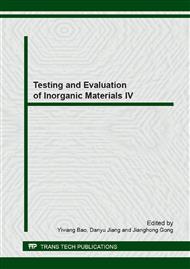p.54
p.61
p.66
p.70
p.75
p.79
p.84
p.90
p.95
Spark Plasma Sintered WC-Ni Cemented Carbides with Various Contents of ZrC Nano-Powder
Abstract:
WC-10Ni cemented carbides with various contents (0-9 wt.%) of ZrC nanopowder were fabricated by spark plasma sintering at 1350 °C with a pressure of 50 MPa. The phase composition, microstructure and mechanical properties of the as-prepared samples were investigated. X-ray diffraction analysis revealed that excepting WC hard phase, a solid solution phase Ni (W,Zr) with different amounts of individual metal was formed with increasing ZrC nanopowder content. Scanning electron microscopy examination indicated that a proper addition content of ZrC can suppress the abnormal growth of WC grains and improve the relative density of WC-Ni cemented carbides. However, with further increase in the content of ZrC (more than 7 wt.%), the agglomeration of ZrC became more and more serious. The samples with 5 wt.% ZrC nanopowder possess a relative higher flexural strength (~1750 MPa) among all the investigated samples. When the addition content of ZrC nanopowder was 3 wt.%, the Vickers hardness of the samples reached its maximum value (~1810 HV10).
Info:
Periodical:
Pages:
75-78
Citation:
Online since:
November 2013
Price:
Сopyright:
© 2014 Trans Tech Publications Ltd. All Rights Reserved
Share:
Citation:


